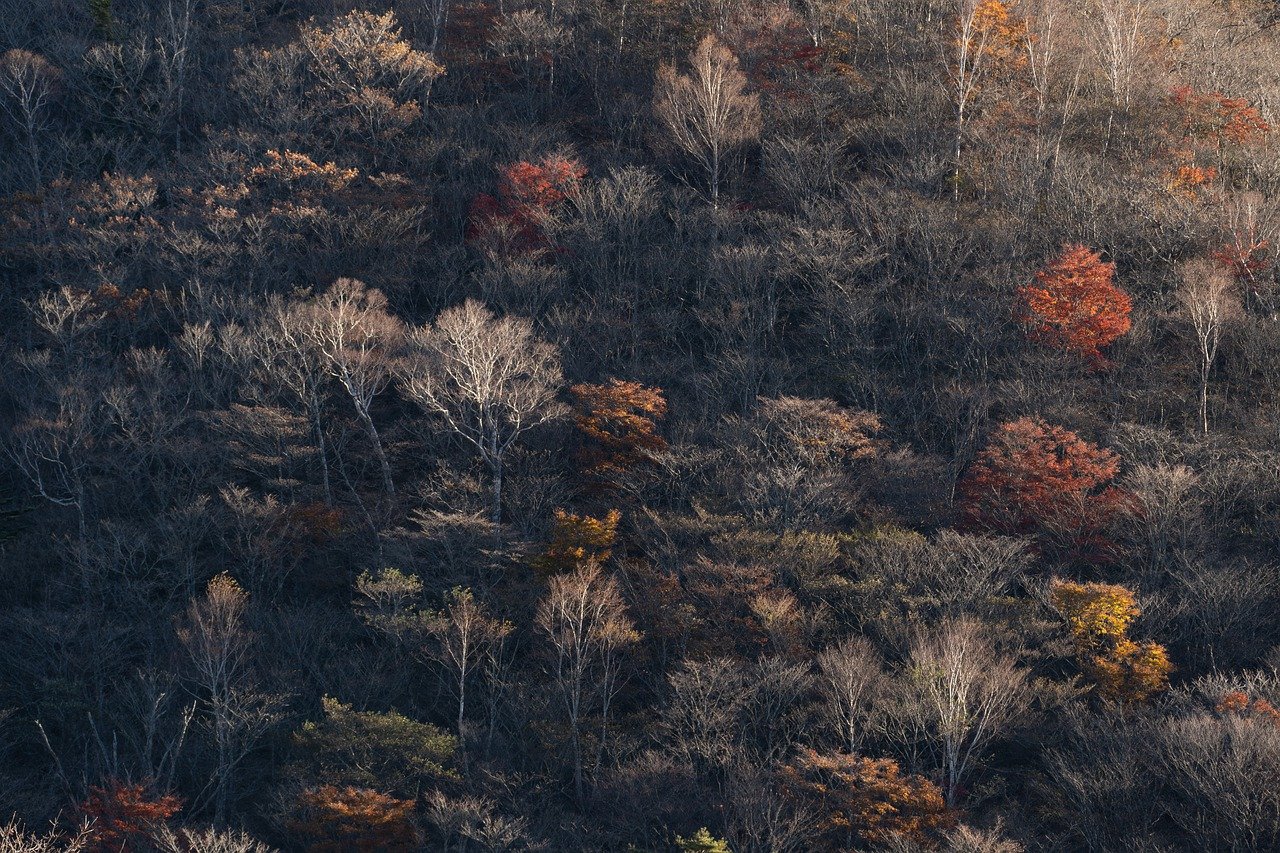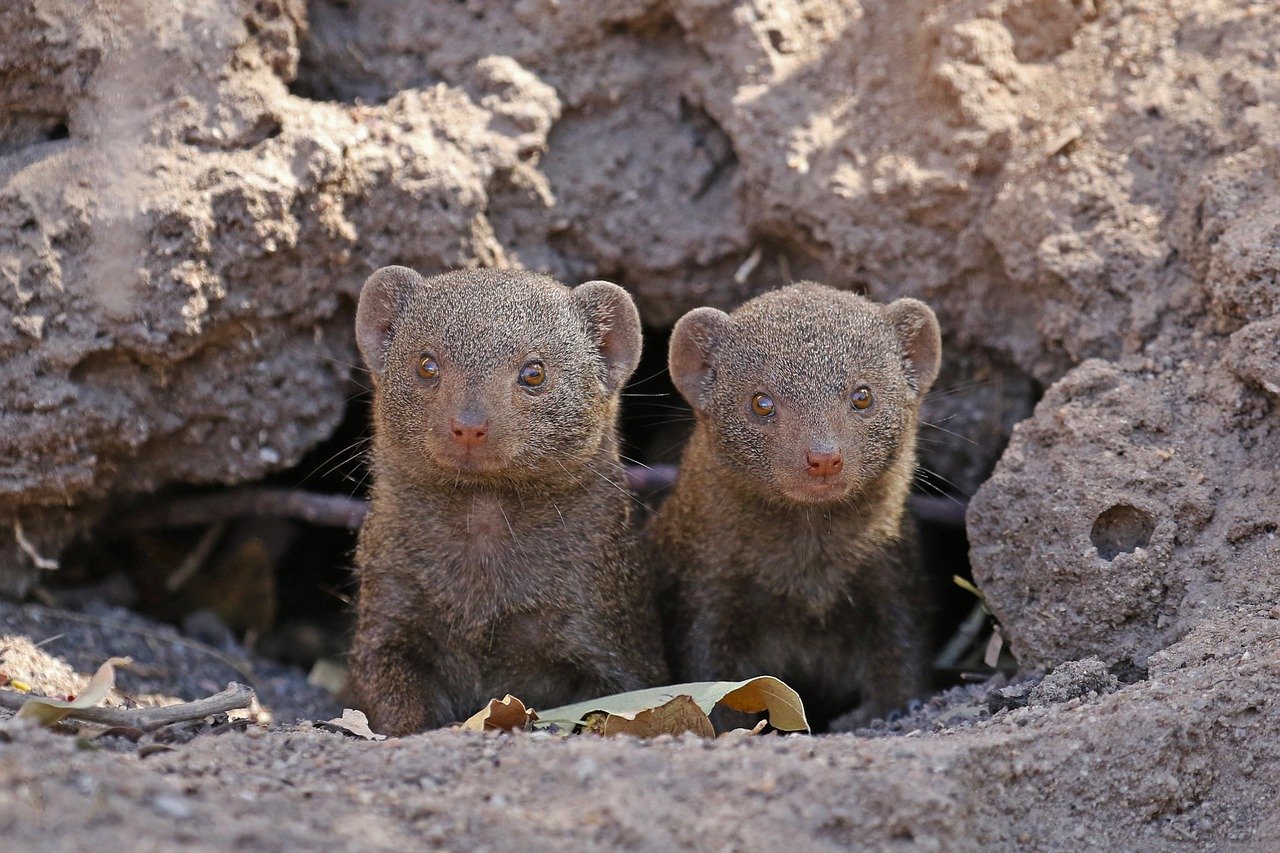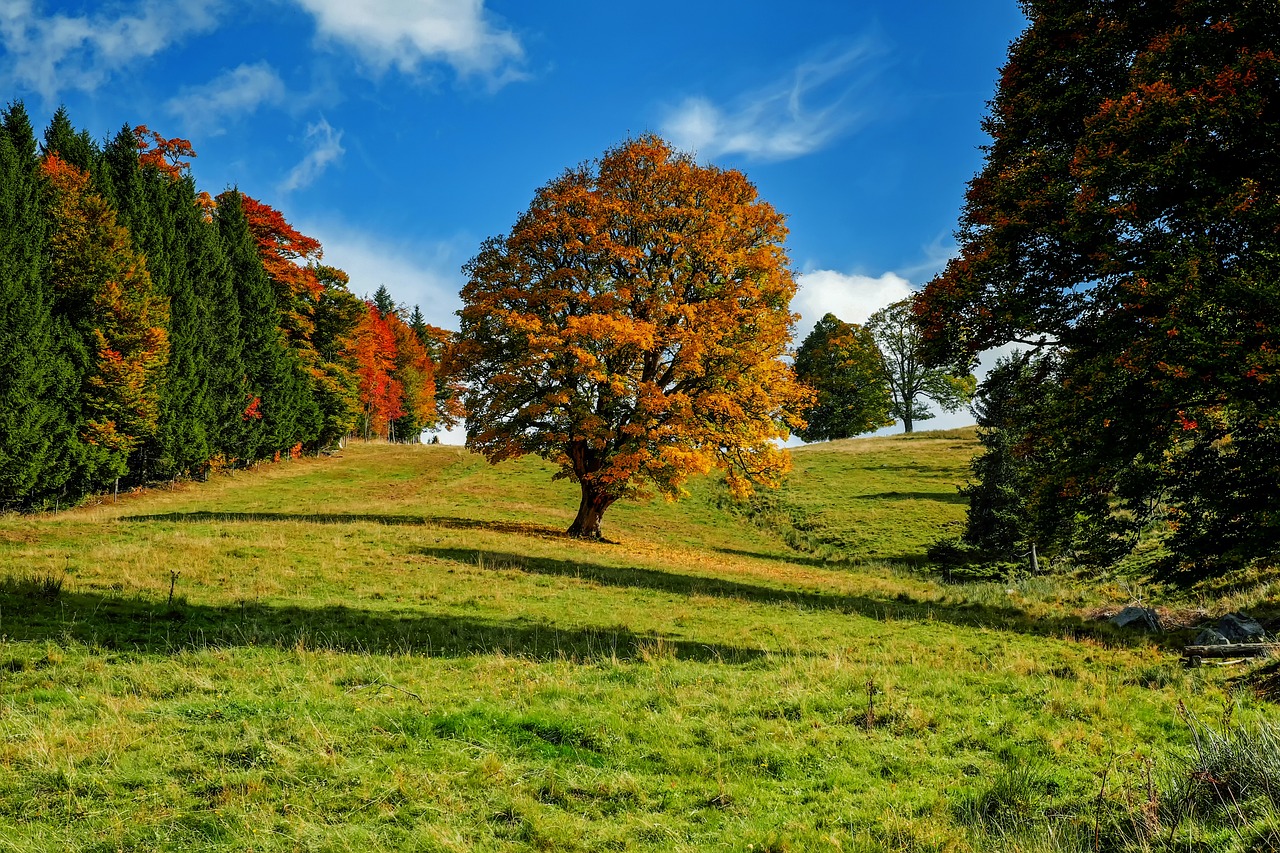The Importance of Forest Conservation in Sustainable Living
Forest conservation is not just a buzzword; it’s a critical necessity for our planet's health and our own survival. Think about it: forests cover about 31% of the Earth's land area, and they are home to countless species of plants and animals, many of which we rely on for food, medicine, and clean air. As we navigate the complexities of modern living, the significance of preserving these green giants becomes increasingly apparent. The benefits of forest conservation stretch far beyond the trees themselves; they encompass environmental, social, and economic dimensions that are essential for sustainable living.
First and foremost, forests play a vital role in maintaining biodiversity. They are the habitat for over 80% of terrestrial wildlife, and without them, many species face extinction. When we conserve forests, we’re not just saving trees; we’re protecting entire ecosystems that are intricately connected. Imagine a web where each strand represents a different species, and if one strand breaks, the entire web becomes weaker. That’s how biodiversity works—every species has its role, and losing even one can have a ripple effect on the entire ecosystem.
Moreover, forests are essential for combating climate change. They act as natural carbon sinks, absorbing carbon dioxide from the atmosphere and helping to mitigate the effects of global warming. With climate change posing one of the greatest threats to our planet, forest conservation is a powerful tool in our arsenal. It’s like having a giant sponge that soaks up excess carbon, helping to keep our climate in balance. As we face increasingly severe weather patterns, the role of forests in enhancing climate resilience cannot be overstated.
On the economic front, forests are invaluable. They provide timber, non-timber products, and recreational opportunities that contribute to local and national economies. Sustainable forest management practices can enhance these economic benefits while ensuring that resources remain available for future generations. For instance, responsible sourcing of timber not only supports local communities but also promotes a healthier ecosystem. It’s a win-win situation where we can enjoy the benefits of forest resources without compromising their integrity.
Additionally, forests are a magnet for tourism, attracting millions of visitors each year. This influx of tourists not only generates revenue for local communities but also raises awareness about the importance of conservation. Picture a family hiking through a lush forest, marveling at the beauty of nature. Their experience fosters a connection to the environment that can inspire them to advocate for its protection. Responsible tourism can create a sustainable cycle where both the environment and the economy thrive.
Lastly, it’s essential to recognize the social and cultural significance of forests. For many indigenous communities, forests are not just resources; they are sacred spaces intertwined with their identity and traditions. The relationship between these communities and their forests is profound, and inclusive conservation efforts that respect indigenous rights and knowledge are crucial. By valuing their perspectives, we can develop more effective conservation strategies that benefit both people and the planet.
- Why is forest conservation important?
Forest conservation is vital for maintaining biodiversity, combating climate change, and supporting local economies. - How do forests help with climate change?
Forests absorb carbon dioxide, acting as natural carbon sinks which help mitigate the effects of global warming. - What are some economic benefits of forest conservation?
Forests provide timber, non-timber products, and tourism opportunities that contribute significantly to local and national economies. - How can individuals contribute to forest conservation?
Individuals can support conservation efforts through responsible consumption, volunteering for local conservation projects, and raising awareness about the importance of forests.

[The Role of Forests in Biodiversity]
Forests are often referred to as the lungs of our planet, and for good reason! They cover about 31% of the Earth's land area and are home to over 80% of terrestrial biodiversity. This staggering statistic highlights the essential role forests play in maintaining ecological balance. Picture a vibrant tapestry of life, where each thread represents a different species, from the tiniest insects to towering trees. Without forests, this intricate web of life would unravel, leading to dire consequences for our planet.
Forests provide habitat for countless species, many of which are found nowhere else on Earth. The loss of these habitats due to deforestation and degradation poses a significant threat to biodiversity. As we continue to encroach on these natural spaces, we risk losing not just the plants and animals that inhabit them, but also the vital ecosystem services they provide. For instance, forests help regulate the climate, purify water, and even pollinate crops. By conserving forests, we are not merely preserving beautiful landscapes; we are safeguarding our own survival.
Moreover, forests serve as crucial carbon sinks, absorbing carbon dioxide from the atmosphere and helping to mitigate climate change. This process not only supports biodiversity but also contributes to the health of our planet. When we protect forests, we are essentially investing in a healthier future for all living beings. The interdependence between forests and biodiversity is undeniable; the loss of one inevitably leads to the decline of the other.
To truly understand the importance of forest conservation, we need to recognize the various ecosystems that exist within forests. Each type of forest—be it tropical, temperate, or boreal—hosts a unique set of species adapted to its specific environment. For example, tropical rainforests are known for their rich biodiversity, housing more than half of the world's plant and animal species despite covering only about 6% of the Earth's surface. This incredible diversity is crucial for ecosystem resilience, enabling forests to recover from disturbances such as wildfires or disease outbreaks.
Furthermore, the relationship between forests and indigenous communities cannot be overstated. Many indigenous peoples have lived in harmony with forests for generations, relying on them for food, shelter, and cultural practices. Their traditional ecological knowledge is invaluable for conservation efforts, offering insights into sustainable practices that have stood the test of time. By involving these communities in conservation initiatives, we can foster a sense of ownership and responsibility towards forest preservation. This collaboration not only benefits biodiversity but also empowers local populations.
In conclusion, the role of forests in maintaining biodiversity is both profound and multifaceted. They are essential for the survival of countless species, provide critical ecosystem services, and support the cultural practices of indigenous peoples. As we face increasing threats from climate change and habitat loss, it is imperative that we prioritize forest conservation. After all, protecting forests means protecting life itself.
- Why are forests important for biodiversity? Forests provide habitat for a vast array of species and contribute to ecological balance.
- How do forests help mitigate climate change? Forests absorb carbon dioxide, acting as carbon sinks that help reduce greenhouse gases in the atmosphere.
- What role do indigenous communities play in forest conservation? Indigenous peoples have valuable traditional ecological knowledge and rely on forests for their livelihoods, making their involvement crucial for effective conservation.
- What can individuals do to support forest conservation? Individuals can support sustainable products, participate in reforestation efforts, and advocate for policies that protect forests.

[Economic Benefits of Forest Conservation]
When we think about forests, we often envision their breathtaking beauty and the tranquil sounds of nature. However, the economic benefits of forest conservation are equally impressive and cannot be overlooked. Did you know that forests contribute significantly to our economy through various avenues such as timber, tourism, and ecosystem services? By preserving these natural resources, we not only protect our environment but also enhance our economic stability. It’s like having a treasure chest that keeps giving while ensuring we don’t deplete its contents!
Forests are a source of livelihood for millions of people around the globe. They provide timber for construction, furniture, and paper products, while also offering non-timber products like fruits, nuts, and medicinal plants. Sustainable forest management is crucial here, as it allows for the harvesting of these resources without compromising the health of the forest. Responsible sourcing ensures that local communities benefit economically while also maintaining ecological balance. Imagine a world where every piece of timber we use comes from a forest that is thriving and healthy; that’s the power of sustainable practices!
Let’s dive deeper into the world of timber and non-timber products. The timber industry alone is a multi-billion dollar sector, but it’s essential to approach it sustainably. Unsustainable logging practices can lead to deforestation, habitat loss, and a decline in biodiversity, which ultimately harms our economy. On the flip side, sustainable forestry practices can create jobs, support local economies, and ensure that forests continue to thrive for generations to come.
Non-timber forest products (NTFPs) are equally important. These include a variety of goods such as berries, mushrooms, and resins. According to the Food and Agriculture Organization (FAO), the global trade in NTFPs is worth billions of dollars annually. By promoting the sustainable harvesting of these products, we can create a win-win situation for both the economy and the environment. It’s like having a buffet where everyone can enjoy the food without emptying the table!
Another significant economic benefit of forest conservation lies in sustainable tourism. Forests attract millions of tourists each year, eager to experience their beauty and biodiversity. This influx of visitors creates economic opportunities for local communities through activities such as guided tours, camping, and wildlife watching. Think of it as a natural theme park where everyone gets to enjoy the wonders of nature while contributing to its preservation.
However, it’s crucial that this tourism is managed responsibly. Overcrowding and environmental degradation can quickly turn this goldmine into a liability. By implementing sustainable tourism practices, we can ensure that both tourists and local communities benefit, while also protecting the forests. It’s all about striking the right balance!
Lastly, let’s talk about the ecosystem services that forests provide. These services include carbon sequestration, water purification, and soil stabilization, all of which have significant economic implications. For instance, forests play a vital role in mitigating climate change by absorbing carbon dioxide from the atmosphere. This service is invaluable, especially as we face the growing threat of climate change. By valuing these services, we can better understand their economic worth and justify the investments needed for forest conservation.
To illustrate this, consider the following table that outlines some key ecosystem services provided by forests and their estimated economic values:
| Ecosystem Service | Estimated Economic Value (per year) |
|---|---|
| Carbon Sequestration | $100 billion |
| Water Purification | $30 billion |
| Biodiversity Support | $50 billion |
| Soil Stabilization | $20 billion |
In conclusion, the economic benefits of forest conservation are undeniable. By investing in sustainable practices, we not only protect our precious forests but also create a robust economy that can thrive for years to come. So, the next time you walk through a forest, remember that it’s not just a collection of trees; it’s a vital part of our economy and our future!
- Why is forest conservation important for the economy? Forest conservation helps maintain biodiversity, supports local economies through sustainable resource management, and provides essential ecosystem services that have significant economic value.
- What are non-timber forest products? Non-timber forest products include a variety of goods such as fruits, nuts, and medicinal plants that can be harvested sustainably without damaging the forest.
- How can tourism benefit forest conservation? Sustainable tourism can provide economic opportunities for local communities while promoting the conservation of forests by encouraging responsible practices among visitors.
- What is ecosystem services valuation? Ecosystem services valuation is the process of assigning economic value to the benefits provided by ecosystems, which can help justify investments in conservation efforts.

[Timber and Non-Timber Products]
When we think about forests, the first thing that often comes to mind is timber, right? It’s like the superhero of the forest world, providing us with the wood we need for construction, furniture, and countless other products. However, forests are not just about timber; they also offer a treasure trove of non-timber products that are equally important for both the economy and the environment. Imagine walking through a forest and coming across fruits, nuts, medicinal plants, and even resins. These are just a few examples of the non-timber products that forests provide, which can be harvested sustainably to support local communities and economies.
Let’s dive deeper into the significance of responsible sourcing. Sustainable forest management practices ensure that we don’t just take from the forest but also give back. It’s like a relationship; it needs to be mutual. By adopting practices such as selective logging and agroforestry, we can harvest timber without depleting the forest's resources. This not only helps in maintaining the ecological balance but also supports local economies by creating jobs and providing livelihoods. For instance, communities that engage in sustainable harvesting of non-timber products like wild mushrooms or berries can generate income while preserving the forest's health.
Moreover, the economic impact of non-timber forest products is substantial. According to various studies, these products can account for a significant portion of rural households' income. They include:
- Medicinal plants used in traditional medicine
- Edible plants and fruits that are harvested for local markets
- Natural resins and gums used in various industries
- Craft materials for artisans and local craftspeople
By promoting the sustainable harvesting of both timber and non-timber products, we can create a win-win situation. Not only do we ensure the forest's health, but we also empower local communities to thrive economically. This approach fosters a sense of stewardship among local populations, encouraging them to protect the forests they depend on. When communities realize that healthy forests can lead to stable incomes, they are more likely to engage in conservation efforts.
In conclusion, the importance of timber and non-timber products in sustainable forest management cannot be overstated. They serve as crucial resources for local communities while also playing a vital role in the overall health of our ecosystems. By adopting sustainable practices, we can ensure that these resources are available for future generations, creating a legacy of environmental stewardship and economic resilience.
Q1: What are non-timber forest products?
Non-timber forest products (NTFPs) include a variety of goods that can be harvested from forests without cutting down trees. This includes fruits, nuts, mushrooms, medicinal plants, and resins.
Q2: Why is sustainable sourcing important?
Sustainable sourcing ensures that forest resources are used responsibly, allowing for regeneration and maintaining ecological balance. It helps protect biodiversity and supports local economies.
Q3: How can communities benefit from sustainable forest management?
Communities can benefit through job creation, income generation from the sale of timber and non-timber products, and improved health and environmental conditions that come from maintaining healthy forests.

[Sustainable Tourism Opportunities]
When you think of forests, what comes to mind? Perhaps the towering trees, the rustling leaves, or the vibrant wildlife? Now, imagine if these majestic ecosystems could also be a source of income for local communities while promoting conservation. This is where sustainable tourism enters the picture. It’s not just a buzzword; it’s a transformative approach that benefits both the environment and the economy. By attracting millions of visitors each year, forests have the potential to generate significant revenue through eco-friendly tourism practices.
Sustainable tourism is all about minimizing the environmental impact while maximizing the benefits for local communities. When tourists choose to visit a forest, they are not just seeking adventure; they are also contributing to the preservation of these vital ecosystems. Think of it like a symbiotic relationship: the forest provides a beautiful backdrop for exploration, and in return, visitors support conservation efforts through entrance fees, guided tours, and local crafts. This creates a win-win situation where nature thrives, and communities prosper.
But what does sustainable tourism look like in practice? Here are a few key aspects:
- Eco-Friendly Accommodations: Lodges and campsites that use renewable energy sources and sustainable materials.
- Responsible Wildlife Viewing: Tours that prioritize animal welfare and educate visitors about local species.
- Community Engagement: Involving local populations in tourism planning and decision-making to ensure their needs and traditions are respected.
Moreover, the economic impact of sustainable tourism extends beyond immediate revenue. It creates jobs, fosters local entrepreneurship, and encourages the preservation of cultural heritage. For instance, indigenous communities can offer unique cultural experiences, such as traditional storytelling or artisanal crafts, which not only enrich the tourist experience but also empower these communities economically. Imagine the stories that can be shared around a campfire, connecting travelers with the rich history of the land!
However, it’s crucial to strike a balance. Over-tourism can lead to environmental degradation, so implementing measures to manage visitor numbers and educate tourists about responsible behaviors is essential. Think of it as a delicate dance: we want to welcome visitors into the forest, but we must also protect the very essence of what makes these natural spaces so special.
In conclusion, sustainable tourism presents an incredible opportunity to support forest conservation while enriching the lives of local communities. By choosing to engage with these natural wonders responsibly, we can ensure that future generations will also have the chance to experience the magic of forests. So, the next time you plan a getaway, consider how your travel choices can make a positive impact. After all, every step you take in the forest is a step towards a more sustainable future!
1. What is sustainable tourism?
Sustainable tourism refers to travel practices that minimize environmental impact while benefiting local communities economically and socially.
2. How can I participate in sustainable tourism?
You can participate by choosing eco-friendly accommodations, respecting wildlife, and supporting local businesses during your travels.
3. What are the benefits of sustainable tourism for local communities?
Sustainable tourism can create jobs, promote cultural heritage, and provide funding for conservation efforts, leading to overall community development.
4. How does over-tourism affect forests?
Over-tourism can lead to environmental degradation, habitat destruction, and strain on local resources, which can harm both ecosystems and communities.

[Ecosystem Services Valuation]
The valuation of ecosystem services provided by forests is a crucial aspect of understanding their true worth beyond mere economic metrics. Ecosystem services refer to the myriad benefits that forests offer, which include, but are not limited to, carbon sequestration, water purification, soil stabilization, and habitat provision for countless species. By quantifying these services, we can better appreciate the vital role forests play in maintaining ecological balance and supporting human well-being.
One of the most significant ways to value these services is through the concept of natural capital. This term encompasses the world's stocks of natural assets, including geology, soil, air, water, and all living things. When we recognize forests as a form of natural capital, it becomes evident that their preservation is not just an environmental issue but a fundamental economic concern. For instance, the Global Forest Resources Assessment estimates that forests provide ecosystem services worth over $100 trillion annually. This staggering figure underscores the necessity of integrating these values into national accounting systems and policy-making processes.
To illustrate the diverse benefits of forest ecosystem services, consider the following table:
| Ecosystem Service | Description | Economic Value (Annual Estimate) |
|---|---|---|
| Carbon Sequestration | Absorption of CO2 from the atmosphere, helping mitigate climate change. | $20 billion |
| Water Regulation | Maintaining water quality and regulating water cycles. | $50 billion |
| Biodiversity Habitat | Providing a home for diverse species, promoting ecosystem resilience. | $30 billion |
| Soil Fertility | Preventing soil erosion and maintaining soil health. | $10 billion |
These figures highlight just a fraction of the economic value that forests contribute through their ecosystem services. However, the challenge lies in effectively communicating this value to policymakers and the public. The integration of ecosystem services into decision-making requires innovative approaches, such as payments for ecosystem services (PES), where landowners are compensated for managing their land in ways that preserve these vital services. This not only incentivizes conservation efforts but also fosters a sense of stewardship among local communities.
Moreover, the valuation of ecosystem services can lead to more sustainable land-use practices. By recognizing the economic benefits of maintaining healthy forests, communities and governments can shift their focus from short-term exploitation to long-term sustainability. This transition is essential for ensuring that future generations can enjoy the myriad benefits that forests provide.
In conclusion, the valuation of ecosystem services is not just a theoretical exercise; it is a practical necessity that can drive conservation efforts and promote sustainable living. By understanding and communicating the true value of forests, we can foster a deeper appreciation for their role in our lives and the planet. This understanding is vital for creating policies that support forest conservation and ultimately contribute to a more sustainable future.
- What are ecosystem services? Ecosystem services are the benefits that humans derive from ecosystems, including clean air and water, pollination of crops, and climate regulation.
- Why is valuing ecosystem services important? Valuing ecosystem services helps to highlight the economic and social importance of natural resources, encouraging sustainable management and conservation practices.
- How can we measure ecosystem services? Ecosystem services can be measured using various methods, including market value assessments, contingent valuation, and ecosystem service modeling.
- What is a payment for ecosystem services (PES)? PES is a financial incentive mechanism that compensates landowners or resource managers for maintaining or enhancing ecosystem services.

[Social and Cultural Significance]
Forests are not just a collection of trees; they are vibrant ecosystems that hold immense social and cultural value for countless communities around the globe. For many indigenous peoples, forests are sacred spaces, rich with history and tradition. They are the very fabric of their identity, spirituality, and way of life. Imagine a tapestry woven with stories, rituals, and practices that have been passed down through generations; this is how deeply intertwined forests are with the cultural heritage of these communities.
Moreover, forests serve as a source of sustenance and livelihood for millions. They provide food, medicine, and materials for shelter. For instance, many communities rely on forest products such as fruits, nuts, and medicinal plants for their daily needs. This interdependence fosters a profound respect for nature, as these communities understand that their survival is linked to the health of the forests. When we think about conservation, it’s crucial to consider how our actions impact these communities and their cultural practices.
In addition to their practical benefits, forests also play a significant role in community cohesion and identity. They are places for gathering, celebration, and education. Many cultural events, festivals, and ceremonies are centered around forests, reinforcing the bond between people and nature. This connection is not only emotional but also educational, as younger generations learn about their heritage and the importance of preserving these vital ecosystems.
However, the pressures of modern development often threaten this delicate balance. Deforestation, urbanization, and industrialization can lead to the displacement of communities and the loss of cultural practices. To combat this, inclusive conservation efforts that honor the rights and knowledge of indigenous peoples are essential. By involving these communities in decision-making processes, we can create sustainable practices that not only protect forests but also empower those who depend on them.
To highlight the significance of forests in cultural contexts, consider the following points:
- Spiritual Connection: Many cultures view forests as sacred spaces, integral to their spiritual beliefs.
- Traditional Knowledge: Indigenous peoples possess invaluable knowledge about forest ecosystems, which can guide sustainable practices.
- Community Identity: Forests are often central to the identity and history of local communities, influencing their customs and traditions.
In conclusion, the social and cultural significance of forests cannot be overstated. They are not merely resources to be exploited but are vital to the identity, economy, and spirituality of many communities. As we move forward in our conservation efforts, we must ensure that we respect and incorporate these cultural dimensions into our strategies. After all, protecting forests is about preserving the very essence of the communities that thrive within them.
- Why are forests important for indigenous cultures? Forests provide a source of sustenance, spiritual connection, and cultural identity for many indigenous communities.
- How can we involve local communities in conservation efforts? Engaging communities in decision-making and recognizing their traditional knowledge can lead to more effective conservation strategies.
- What are the consequences of deforestation on cultural practices? Deforestation can lead to the loss of resources, displacement of communities, and the erosion of cultural traditions.

[Climate Change Mitigation]
When we think about climate change, it often feels like an overwhelming problem, doesn’t it? Yet, one of the most powerful allies we have in this fight is right in our backyards: our forests. These green giants are not just pretty landscapes; they are crucial players in the battle against climate change. By absorbing carbon dioxide from the atmosphere, forests act like massive sponges, soaking up greenhouse gases and helping to regulate our climate. This natural process is known as carbon sequestration, and it’s vital for reducing the impacts of climate change.
But how exactly do forests contribute to climate change mitigation? First off, they store carbon in their biomass—think of the trees, plants, and soil as a giant bank where carbon is deposited and held for years, sometimes even centuries. When trees grow, they absorb carbon dioxide through photosynthesis and store it as carbon in their trunks, branches, leaves, and roots. According to recent studies, forests store about 289 gigatons of carbon globally, which is equivalent to the annual emissions of over 60 billion cars!
Moreover, forests not only sequester carbon but also help in maintaining climate resilience. They act as natural barriers against extreme weather events, such as floods and droughts. For instance, tree canopies intercept rainfall, reducing soil erosion and runoff, while their root systems stabilize the ground. This means that healthy forests can mitigate the effects of climate change and protect communities from its worst impacts.
However, it's crucial to understand that not all forests are created equal. The type of forest, its health, and the biodiversity it supports all play a significant role in its effectiveness as a carbon sink. Deforestation and forest degradation release stored carbon back into the atmosphere, exacerbating climate change. Thus, protecting existing forests and restoring degraded ones is not just beneficial but absolutely necessary. Initiatives such as reforestation and afforestation are key strategies in this regard. They involve planting trees in deforested areas or creating new forests in previously non-forested areas, respectively.
Take a look at this table that highlights the benefits of forest conservation in climate change mitigation:
| Benefit | Description |
|---|---|
| Carbon Sequestration | Forests absorb carbon dioxide, reducing greenhouse gas concentrations in the atmosphere. |
| Climate Resilience | Forests provide natural barriers against extreme weather, protecting ecosystems and communities. |
| Biodiversity Support | Healthy forests support diverse species, which are essential for ecosystem stability and resilience. |
| Soil Protection | Tree roots stabilize soil, reducing erosion and enhancing water retention. |
In conclusion, the relationship between forests and climate change is a vital one. By conserving our forests, we are not just preserving beautiful landscapes; we are investing in our planet's future. Every tree we protect and every forest we restore is a step toward a healthier Earth. So, the next time you enjoy a walk in the woods, remember that you are part of a larger movement—one that champions sustainability and champions our fight against climate change.
- How do forests help in climate change mitigation? Forests absorb carbon dioxide, acting as carbon sinks and helping to stabilize the climate.
- What is carbon sequestration? It is the process by which trees and plants absorb carbon dioxide from the atmosphere and store it in their biomass.
- Why is reforestation important? Reforestation helps restore ecosystems, supports biodiversity, and enhances carbon sequestration efforts.
- Can urban areas benefit from forest conservation? Absolutely! Urban forests can improve air quality, reduce heat, and provide recreational spaces for communities.

[Carbon Sequestration Mechanisms]
Understanding carbon sequestration mechanisms is crucial in our fight against climate change. Simply put, carbon sequestration is the process by which carbon dioxide (CO2) is captured and stored, preventing it from entering the atmosphere. Forests are nature's own carbon sinks, absorbing CO2 during photosynthesis and storing it in their biomass—leaves, stems, branches, and roots. This natural process not only helps mitigate the impacts of climate change but also plays a vital role in maintaining ecological balance.
There are several mechanisms through which forests sequester carbon, and each plays a unique role in the overall process. The primary mechanism is photosynthesis, where trees convert sunlight into energy while absorbing CO2. As trees grow, they accumulate biomass, which is essentially carbon stored in their structure. Moreover, when trees die and decompose, or when they are harvested sustainably, this carbon can be released back into the atmosphere. However, responsible management practices can ensure that this carbon remains stored for extended periods.
Another important mechanism is soil carbon storage. Forests contribute to soil health by enhancing organic matter content through leaf litter and root decay. Healthy soils can store significant amounts of carbon, often more than the trees themselves. Research indicates that forest soils can hold up to three times more carbon than the atmosphere, making soil management a critical aspect of carbon sequestration strategies.
To illustrate the importance of these mechanisms, consider the following table that outlines the different carbon sequestration processes and their contributions:
| Sequestration Mechanism | Description | Carbon Storage Potential |
|---|---|---|
| Photosynthesis | Trees absorb CO2 and convert it into biomass. | Varies by species and age; mature forests store significant amounts. |
| Soil Carbon Storage | Organic matter from trees enhances soil carbon content. | Can store up to three times more carbon than the atmosphere. |
| Forest Management | Practices that promote healthy forests and soil. | Improves overall carbon storage capacity. |
In addition to these mechanisms, restoration and reforestation efforts are pivotal in enhancing carbon sequestration. By planting new trees and restoring degraded forests, we can significantly increase the amount of carbon stored in both biomass and soil. For instance, a single mature tree can absorb approximately 48 pounds of CO2 per year. Imagine the impact if we collectively worked towards planting millions of trees!
It's also essential to recognize that while forests are powerful allies in carbon sequestration, they are not a silver bullet. The effectiveness of these mechanisms can be influenced by various factors, including climate conditions, forest management practices, and land use changes. Therefore, integrating forest conservation into broader climate strategies is vital for maximizing their benefits.
In conclusion, understanding carbon sequestration mechanisms is not just an academic exercise; it is a call to action. By protecting our forests and promoting sustainable practices, we can harness their potential to combat climate change and secure a healthier planet for future generations. So, the next time you take a walk in the woods, remember that those trees are doing more than just providing shade—they're actively fighting against climate change, one carbon molecule at a time.
- What is carbon sequestration?
Carbon sequestration is the process of capturing and storing carbon dioxide to prevent it from entering the atmosphere. - How do forests sequester carbon?
Forests absorb CO2 during photosynthesis and store it in their biomass and soil. - Why is soil carbon storage important?
Healthy soils can store significant amounts of carbon, often more than the trees themselves, contributing to climate change mitigation. - What can I do to help with carbon sequestration?
You can support reforestation efforts, practice sustainable land use, and reduce your carbon footprint.

[Restoration and Reforestation Efforts]
Restoration and reforestation are not just buzzwords; they are essential strategies in the fight against forest loss and degradation. As we look around, it’s evident that our forests are under siege from various threats, including deforestation, climate change, and urbanization. The good news is that we have the power to turn things around. By implementing effective restoration and reforestation efforts, we can breathe life back into our ecosystems and promote biodiversity. Imagine a world where once barren lands are transformed into lush forests, teeming with wildlife and vibrant plant life. This is not just a dream; it’s a possibility that can be achieved through collective action.
Successful restoration projects have already demonstrated the potential for revitalizing degraded landscapes. For instance, the Great Green Wall initiative in Africa aims to restore 100 million hectares of land across the Sahel region. This ambitious project not only combats desertification but also enhances food security and creates jobs for local communities. Such efforts highlight the interconnectedness of environmental health and human well-being. When we restore forests, we are not merely planting trees; we are sowing the seeds of hope for future generations.
Moreover, reforestation plays a crucial role in carbon sequestration, which is vital for mitigating climate change. Forests act as carbon sinks, absorbing carbon dioxide from the atmosphere and storing it in biomass and soil. This process is essential in reducing greenhouse gas emissions and combating global warming. According to recent studies, restoring degraded forests can potentially sequester up to 1.1 billion tons of carbon dioxide annually. This is a staggering figure that underscores the importance of prioritizing reforestation efforts in our climate strategies.
To effectively implement restoration and reforestation initiatives, several key steps must be taken:
- Assessing the Landscape: Understanding the specific needs and conditions of the area is crucial. This includes evaluating soil quality, local flora and fauna, and climate conditions.
- Community Involvement: Engaging local communities in the planning and execution of restoration projects ensures that their needs and knowledge are incorporated, leading to more sustainable outcomes.
- Diverse Planting: Utilizing a mix of native species in reforestation efforts enhances biodiversity and ecosystem resilience. Native plants are better adapted to local conditions and support local wildlife.
- Monitoring and Maintenance: Continuous monitoring of restored areas is vital to ensure the success of reforestation efforts. This includes regular assessments and maintenance to address any challenges that may arise.
In addition to environmental benefits, restoration and reforestation efforts can yield significant economic advantages. By creating green jobs in planting, maintenance, and monitoring, local economies can thrive. Furthermore, healthy forests support tourism, which can be a substantial revenue source for communities. It’s a win-win situation: we restore the environment while also boosting local economies.
In conclusion, restoration and reforestation are indispensable for a sustainable future. They not only combat the adverse effects of climate change but also revitalize ecosystems, enhance biodiversity, and support local communities. As we move forward, it is imperative that we prioritize these efforts and commit to a greener, more sustainable world. Together, we can transform our landscapes and create a legacy of thriving forests for generations to come.
- What is the difference between restoration and reforestation? Restoration refers to the process of returning a degraded ecosystem to its natural state, while reforestation specifically involves replanting trees in deforested areas.
- Why are native species important in reforestation? Native species are adapted to local conditions and provide essential habitat for wildlife, making them crucial for restoring ecological balance.
- How can individuals contribute to reforestation efforts? Individuals can support local reforestation projects, volunteer for tree-planting events, and promote sustainable practices in their communities.
Frequently Asked Questions
-
Why is forest conservation important for biodiversity?
Forests are like the lungs of our planet, housing over 80% of terrestrial biodiversity. By conserving forests, we help maintain these vital ecosystems, ensuring countless species have a home and protecting them from extinction. Think of it as safeguarding a treasure trove of life that benefits not just nature, but us too!
-
How do forests contribute to the economy?
Forests are a goldmine of economic opportunities! They provide timber, support tourism, and offer various ecosystem services. Sustainable practices allow us to harvest these resources responsibly, ensuring that local communities thrive economically while preserving the forest for future generations. It's a win-win situation!
-
What are ecosystem services, and why do they matter?
Ecosystem services are the benefits we get from nature, like clean air and water, carbon sequestration, and soil fertility. Valuing these services is crucial because they highlight the importance of forests in maintaining our planet's health. When we recognize their worth, we can implement better conservation strategies that protect these invaluable resources.
-
How do forests help combat climate change?
Forests are nature's climate warriors! They absorb carbon dioxide, helping to mitigate climate change. By conserving our forests, we not only protect biodiversity but also enhance our global climate strategies. This means healthier ecosystems and a more resilient planet for everyone!
-
What is the significance of indigenous cultures in forest conservation?
Indigenous cultures have a deep-rooted connection to forests, often viewing them as sacred. Their traditional knowledge and practices can guide effective conservation efforts. By including these communities in conservation strategies, we foster a more inclusive approach that respects their cultural significance while promoting sustainability.
-
What are some successful reforestation efforts?
There are numerous inspiring reforestation projects around the globe! For instance, initiatives in Madagascar and Brazil have successfully restored vast areas of forest, enhancing biodiversity and improving local livelihoods. These stories prove that with commitment and collaboration, we can reverse forest loss and create a healthier planet.



















